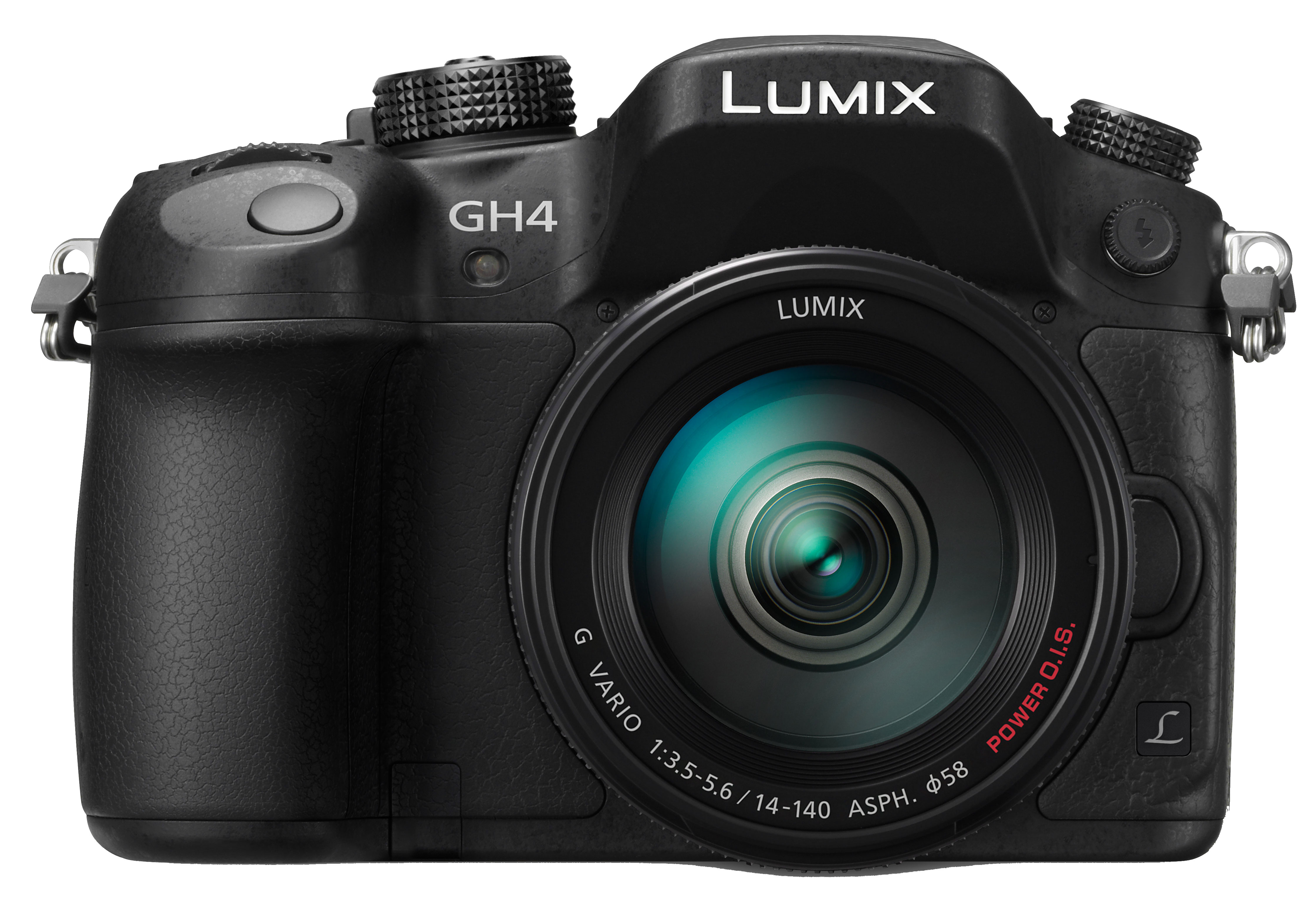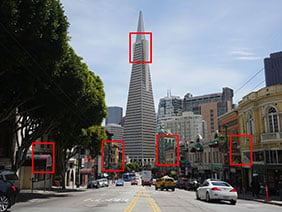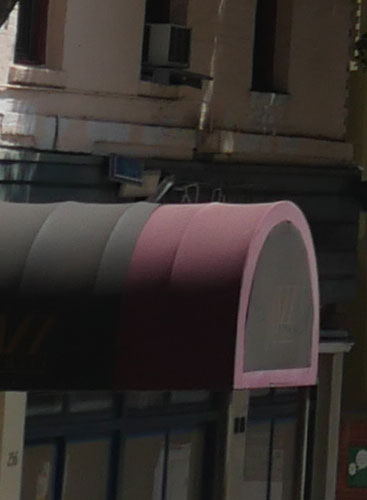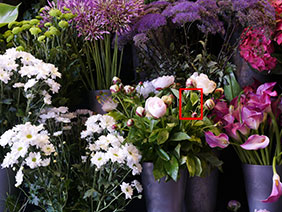
Panasonic Lumix GH4 review
-
-
Written by Gordon Laing
Quality
Panasonic Lumix GH4 vs Olympus OMD EM1

To compare real-life performance I shot this scene with the Panasonic Lumix GH4 and Olympus OMD EM1 within a few moments of each other using their RAW+JPEG modes; my RAW comparison will follow as soon as the GH4 is supported in ACR. Both cameras were fitted in turn with the same Olympus 17mm f1.8 lens, set to f4 in Aperture Priority mode. The crops below are taken from the areas marked by the red rectangles opposite.
In my first comparison I’ve fitted both cameras in turn with the same lens, the Olympus 17mm f1.8, closed to f4 where it performs at its best for the subject distance in the photo. Since the lens was the same, it allows us to compare the sensor and image processor of each camera, and on this page I’m looking at out-of-camera JPEGs using the default settings. Once the GH4 is supported by Adobe Camera RAW, I’ll add a RAW comparison.
When comparing photos taken with the GH4 and EM1 from the same position with the same lens, it’s interesting to note the GH4 captures a fractionally narrower field of view. This indicates the GH4’s active sensor area is actually a fraction smaller than the EM1’s. The difference is so small to be almost imperceptible, but I wanted to point it out, as it explains why the areas in the GH4 crops are a tad smaller than those from the EM1 crops despite both sharing the same 4608×3456 pixel image resolution.
Looking at the crops below, the right column from the Olympus OMD EM1 looks more contrasty and a little sharper too. Blacks are blacker and edges are a little better defined. I put most of this down to image processing rather than sensor performance, as it’s relatively simple to apply more contrast and sharpening to the GH4 images and end up with a similar result, or of course vice versa.
So is there any difference in actual recorded detail? Take a look at the first row of crops from the top of the Transamerica Pyramid and you’ll notice evidence of vertical lines in the upper structure of the EM1 version which are smeared-out on the GH4. This could be down to more aggressive noise reduction on the GH4, or perhaps it could be the absence of an optical low pass filter on the EM1 giving it a little extra ultimate detail.
It’s hard to say until I get a chance to process the RAW files with the same settings, for which I’m waiting for support from Adobe. But for now I’d say both cameras share essentially the same degree of real-life detail for in-camera JPEGs with a tiny edge to the OMD EM1. In terms of image processing, the GH4 defaults are more laid back than the EM1, resulting in a softer appearance for the Lumix compared to a punchier approach from the Olympus, although as noted above, you can tweak picture styles (or indeed JPEGs on your computer) to deliver similar results.
Now it’s time to compare their performance in low light with my Lumix GH4 noise quality results, or if you’ve seen enough, check out my Lumix GH4 sample images or skip straight to my verdict!
Panasonic Lumix GH4 JPEG Using Olympus 17mm f1.8 at f4 | Olympus OMD EM1 JPEG Using Olympus 17mm f1.8 at f4 | |
 |  | |
f4, 200 ISO | f4, 200 ISO | |
 |  | |
f4, 200 ISO | f4, 200 ISO | |
 |  | |
f4, 200 ISO | f4, 200 ISO | |
 |  | |
f4, 200 ISO | f4, 200 ISO | |
 |  | |
f4, 200 ISO | f4, 200 ISO |
Panasonic Lumix GH4 vs Olympus OMD EM1 Noise

To compare noise levels under real-life conditions, I shot this scene with the Panasonic Lumix GH4 and Olympus OMD EM1 within a few moments of each other at each of their ISO sensitivities. My RAW comparison will follow as soon as the GH4 is supported by ACR. Both cameras were fitted in turn with the same Lumix 25mm f1.4 lens, set to f5.6 in Aperture Priority mode. The crops below are taken from the area marked by the red rectangle opposite.For my noise comparison I fitted both cameras in turn with the same lens, the Lumix 25mm f1.4, closed to f5.6 where it performs at its best for the subject distance in the photo. Since the lens was the same, it allows us to compare the sensor and image processor of each camera, and on this page I’m looking at out-of-camera JPEGs using the default settings. Once the GH4 is supported by Adobe Camera RAW, I’ll add a RAW comparison.
When comparing photos taken with the GH4 and EM1 from the same position with the same lens, it’s interesting to note the GH4 captures a fractionally narrower field of view. This indicates the GH4’s active sensor area is actually a fraction smaller than the EM1’s. The difference is so small to be almost imperceptible, but I wanted to point it out, as it explains why the areas in the GH4 crops are a little smaller than those from the EM1 crops despite both sharing the same 4608×3456 pixel image resolution.
The first thing you’ll notice from the crops below is a repeat of my outdoor resolution tests: the OMD EM1 is applying more contrast and sharpening for a punchier out-of-camera result, while the Lumix GH4 is being more laid-back with its processing for a more subdued result. While the Olympus approach here can deliver more striking output at low ISOs though, it does run the risk of making any noise artefacts more obvious as the sensitivity increases.
And yet as the ISO increases in the sequence below, I’d say the noise becomes more visible on the GH4 first, and while the OMD EM1 is undoubtedly applying noise reduction which is gradually smearing out detail, it’s doing a better job at balancing on this tricky tightrope. Look at the 1600 and 3200 ISO crops for example where there’s less visible noise on the EM1 crops, yet more detail too. At these sensitivities and especially at 6400 ISO and above, the GH4 is really losing detail to noise, whereas the EM1 is still managing to keep hold of a respectable degree.
Now neither camera is going to be a low light monster thanks to the relatively small surface area of the Micro Four Thirds format. But from the crops below I’d say the OMD EM1 is delivering better-looking output using the default JPEG settings at higher ISOs. I’m not entirely surprised by this as Olympus has one of the best JPEG engines around and it really understands the limitations of its sensor in order to deliver the best possible result.
Is the EM1 actually less noisy than the GH4 though? I suspect they’ll be closer than this page suggests when I take the RAW files and process them with the same settings. I think what we’re mostly seeing here is a superior JPEG engine from Olympus. But until Adobe supports the GH4 RAW files I’m just speculating, so check back when the update to ACR is available and I’ll add my RAW comparisons.
Now check out my Panasonic Lumix GH4 sample images or skip straight to my verdict!
Panasonic Lumix GH4 JPEG Using Lumix 25mm f1.4 at f5.6 | Olympus OMD EM1 JPEG Using Lumix 25mm f1.4 at f5.6 | |
 |  | |
f5.6 100 ISO | f5.6, 100 ISO | |
 |  | |
f5.6 200 ISO | f5.6 200 ISO | |
 |  | |
f5.6 400 ISO | f5.6 400 ISO | |
 |  | |
f5.6 800 ISO | f5.6 800 ISO | |
 |  | |
f5.6 1600 ISO | f5.6 1600 ISO | |
 |  | |
f5.6 3200 ISO | f5.6 3200 ISO | |
 |  | |
f5.6 6400 ISO | f5.6 6400 ISO | |
 |  | |
f5.6 12800 ISO | f5.6 12800 ISO | |
 |  | |
f5.6 25600 ISO | f5.6 25600 ISO |




